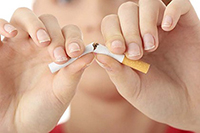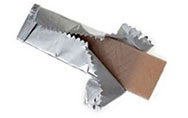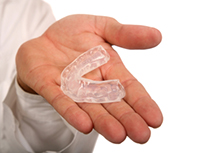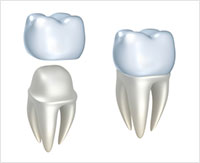Oral Health Tips
Do I need my Wisdom Teeth Removed?
 Having your wisdom teeth removed is almost as commonplace now as a routine dental checkup. For most people, having their wisdom teeth removed is an expected part of their teenage years, but how do you know when the right time is or if you even need to have your wisdom teeth removed? Wisdom teeth are ancillary teeth at the very back of your mouth. They are also known as third molars. They often come in during the teenage years and can cause problems with your other teeth and your bite. While once thought necessary during ancient times, now wisdom teeth often cause more problems and provide no added benefit. Here is some important information to help you decide whether you need your wisdom teeth removed:
Having your wisdom teeth removed is almost as commonplace now as a routine dental checkup. For most people, having their wisdom teeth removed is an expected part of their teenage years, but how do you know when the right time is or if you even need to have your wisdom teeth removed? Wisdom teeth are ancillary teeth at the very back of your mouth. They are also known as third molars. They often come in during the teenage years and can cause problems with your other teeth and your bite. While once thought necessary during ancient times, now wisdom teeth often cause more problems and provide no added benefit. Here is some important information to help you decide whether you need your wisdom teeth removed:
- Often the most common reason to have your wisdom teeth removed is because of space within your mouth or jaw. Wisdom teeth come in at the very back of the jaw line where there is already very limited space. As they begin to emerge they can cause serious crowding and even push other teeth forward. This can cause pain, misalignment of the bite, and other concerns.
- While it is possible for wisdom teeth to come in without problem, very few do. Many wisdom teeth because of their location will come in at an angle or crooked. The angle they come in at can aggravate other dental conditions as well as mean that new tooth is coming in directly against another tooth. If left untreated crooked teeth can permanently damage other surrounding teeth and your bite.
- Teeth that don’t begin to emerge can become impacted. An impacted tooth is one that is trying to push through the gums but becomes stuck or impacted and cannot grow through. There are many reasons this can happen including the angle of the tooth and the available space in the jaw.
- Wisdom teeth coming through the gum will often cause pain and swollen gums. A cyst could also develop. These are other indicators for removal.
- Even if you wisdom teeth begin to emerge without problems, there can be reason for their removal later. One of the reasons is that the gum area around the tooth may be come inflamed or infected or the tooth itself could get a cavity. When infection or inflammation develops in the gum surrounding wisdom teeth they are often easier to remove than to cure.
With the many complications that can occur from emerging wisdom teeth, it has become commonplace to have them removed during early teenage years while the roots are still less developed and before problems during emersion can occur. When you make the decision to have your wisdom teeth removed you have two options, extraction or surgery. If the teeth are already through the gum line you can try for extraction. For teeth that have not emerged or that are in smaller spaces choosing a surgical extraction will provide the best results. Your dentist can best advise you when the best timing for your wisdom teeth removal will be.
How to Floss Properly and Why You Should Floss
 Flossing between teeth is a very important part of oral hygiene. Brushing alone cannot remove the food particles between teeth as the bristles can only reach the surface and partway around the sides. Brushing without flossing can eventually lead to plaque, gum disease, and cavities. Flossing should be done at least once daily, if not twice, and anytime noticeable food is caught between the teeth. This article will detail how to floss properly and why flossing is important. Our dental hygienists will demonstrate how to floss during your visit and ensure you’re able to accomplish flossing on your own.
Flossing between teeth is a very important part of oral hygiene. Brushing alone cannot remove the food particles between teeth as the bristles can only reach the surface and partway around the sides. Brushing without flossing can eventually lead to plaque, gum disease, and cavities. Flossing should be done at least once daily, if not twice, and anytime noticeable food is caught between the teeth. This article will detail how to floss properly and why flossing is important. Our dental hygienists will demonstrate how to floss during your visit and ensure you’re able to accomplish flossing on your own.
Before you floss, you must choose your type of floss. It comes in multifilament nylon floss or monofilament PTFE floss. The nylon floss comes waxed or unwaxed, flavored or unflavored, and has a rougher texture for more friction against the particles on the teeth. But it can shred in tight spaces. The PTFE floss is more expensive and is very thin and slippery, but when used correctly is just as effective and is also shred resistant.
Once you have purchased the floss of your choice, flossing begins with about 18 inches of floss. It is recommended that you wind most of the floss around your two middle fingers, leaving about an inch or two of floss to work with at a time.
Then, use your thumbs and index fingers to hold the floss firmly and slip it in-between the first two teeth to be flossed. Now many people fail to floss properly with this step, leaving residue that can wreak havoc in the mouth. It is vital that the floss be curved around the side of each tooth from the base to the top to scrape those inside areas. Simply running the floss between the two teeth would only remove the largest of particles, leaving plaque on the sides of the teeth.
Try to be careful, when flossing, to not injure the gums. For example, pulling too hard to get the floss between two teeth could snap the floss down sharply against the gums and make them bleed. So try sliding back and forth to get into tight spaces, rather than pulling hard.
Once the space between one set of teeth is done, rotate the floss on your fingers to provide another inch or two of clean floss for the next section. Repeat this process throughout the mouth until the sides of all the teeth have been scraped and then throw the used floss away.
Why are My Gums Receding?
 While many people understand the importance of eating right and exercising to maintain their overall health, oral health can often be neglected or dismissed. When you begin to notice pain or sensitivity when you eat it could be a sign of neglected oral health, and left untreated can lead to not only oral health problems but more serious health complications as well. Receding gums are a serious oral health concern that should be addressed quickly. Here are some of the reasons why your gums may be receding:
While many people understand the importance of eating right and exercising to maintain their overall health, oral health can often be neglected or dismissed. When you begin to notice pain or sensitivity when you eat it could be a sign of neglected oral health, and left untreated can lead to not only oral health problems but more serious health complications as well. Receding gums are a serious oral health concern that should be addressed quickly. Here are some of the reasons why your gums may be receding:
- Insufficient dental care. One of the leading causes of receding gums is the lack or inconstancy of dental care. Not only will insufficient or inconsistent dental care eventually lead to receding gum lines it can lead to many cavities, tooth decay, and even damage to roots. This will lead to more pain and illness as well as more expensive dental care and repair later on. It’s important to follow suggested guideline and have routine dental checkups done at least twice a year to ensure good oral health and to take care of any dental procedures and repairs quickly.
- Brushing too hard. Your gums are the most sensitive area in your mouth. While brushing and flossing is vital to good oral health, it is possible to damage your gum line and cause them to recede if you brush to hard or use a toothbrush with hard bristles. Your dentist can suggest the right toothbrush as well as show you proper brushing techniques. Using a toothbrush that is designed to clean your teeth while massaging your gums will allow for better oral health.
- Hormonal changes. As you age you may notice changes in your gum line that you have no control over. Hormonal changes can happen during puberty, pregnancy, and menopause that will affect your gums. During these times if you notice your gums seem more sensitive than normal be gentler when brushing, and talk to your dentist about any specific areas of concern.
- Genetics. Just as hormones can affect your gums, so can genetics. Those who have a predisposition to dental concerns should be more proactive in their checkups and with talking to a dentist to take preventative measures.
- Habits. There are several habits that can also affect your dental health and your gums. These habits include smoking, tobacco use, and grinding teeth. Many habits can negatively impact your teeth and gums. If you notice a problem being caused by bad habits, work to change them.
- Periodontal disease. A gum infection is a serious concern because it the infection if not treated can begin to eat away at and destroy both gum tissue as well as teeth. These infections need to be treated by a dentist as quickly as possible to ensure better oral health.
While the cause of your gums receding could be one of many, the solution is to visit with a dentist to determine the extent of the receding gum line, address the underlying cause, and follow a dentist’s advice to help repair the damage and reverse the effects. Keeping your gums healthy will not only make eating more enjoyable it can have a dramatic impact in your overall health and wellbeing.
Why are My Teeth Yellow?
 Teeth discoloration can be caused by a variety of different factors. In most cases you can remedy yellow teeth with simple lifestyle changes. However, in most cases it is easier to prevent yellow teeth, than having to cure them. Some of the primary reasons you may have yellow or discolored teeth include:
Teeth discoloration can be caused by a variety of different factors. In most cases you can remedy yellow teeth with simple lifestyle changes. However, in most cases it is easier to prevent yellow teeth, than having to cure them. Some of the primary reasons you may have yellow or discolored teeth include:
- Certain foods and drinks can actually stain your teeth enamel. Some of the most common culprits include wine, colas, tea, coffee, apples and potatoes.
- Smoking and chewing tobacco can also severely stain teeth enamel.
- If you do not frequently brush your teeth, especially after consuming extremely staining foods or smoking, you will notice a higher rate of discoloration.
- There are certain diseases and medical conditions that can also affect the enamel of your teeth. For example, radiation to the head and neck can cause yellowing; additionally some infections that are present in pregnant women can affect the color of your teeth.
- Antibiotics can cause yellowing and discoloration of the teeth. Additionally, antihistamines and high blood pressure medications can cause various levels of discoloration.
- Certain materials that are used in dentistry that contain silver sulfide can cause a gray-black shade to appear on teeth. It is much better for the color of your teeth to use white dental fillings.
- Yellowing colored teeth are also a symptom of aging individuals. This is because as the actual outer enamel layer is worn away, the original color of the dentin becomes visible.
- Some sources of trauma or injury can cause the enamel in children and adults to become discolored.
- Some people are genetically predisposed to yellowing enamel for your teeth. While there is no way to prevent this cause, you can correct the coloring that has occurred.
There are simple lifestyle changes that can be implemented to reduce the yellowing of your teeth. For example, if you drink coffee regularly you may consider cutting back on your consumption or eliminating it altogether. This holds true for tobacco products as well. In most cases, these changes will prevent the condition from worsening, however you may be stuck with the color your teeth are presently. There are solutions for this as well.
With innovative technology you can easily reverse the appearance of yellowing enamel. This can be done by having a dentist professionally bleach your teeth, or use any number of the over the counter products that are available. These methods will noticeably whiten and brighten your teeth. Some products even provide immediate results, that get increasingly more prominent with the more treatments that are used.
Does Smoking Damage Your Teeth?
 Millions of American smoke. Most smokers know the damaging effects that this habit can have on your overall health, however, are you aware of the damaging effects that smoking can have on your teeth? Some of the results of smoking to your teeth are unable to be reversed, meaning even if you quit you are left with the consequences. Use the following guide to understand all of the damaging effects smoking can have on your dental health.
Millions of American smoke. Most smokers know the damaging effects that this habit can have on your overall health, however, are you aware of the damaging effects that smoking can have on your teeth? Some of the results of smoking to your teeth are unable to be reversed, meaning even if you quit you are left with the consequences. Use the following guide to understand all of the damaging effects smoking can have on your dental health.
Two of the most common and well-known negative side effects of smoking to your dental health include: yellow or dingy looking teeth and bad breath. Both of these problems are caused by an increase of bacteria that accumulates due to smoking. In most cases this problem persists even with teeth brushing, mouth washes and chewing gum.
While bad breath and yellow teeth can be seen, there are some problems that can occur that are not noticed until it is too late. These include quickly receding gums, teeth that become brittle and crumble as well as damage to the bone beneath the gum in the mouth. These problems can typically not be reversed, however quitting smoking can reduce the damage that occurs.
For those who continue to smoke for years the ultimate damage may be that their teeth actually fall out. Once this occurs you are left to purchase dentures, partials or go without. However, while losing teeth may seem like the ultimate consequence, the damage does not stop there. Continued smoking can lead to a condition known as dental decay which has been linked to heart disease and other chronic illnesses. Additionally, smoking regularly for years can lead to oral cancer.
When you think about the many consequences to your dental health that can occur simply by lighting up, you must ask yourself “is it really worth it?” The fact is there are many programs, hotlines and products available to help smokers quit. Listed here are the problems that occur to your dental health, this list does not include the other detrimental issues that smoking can cause.
Keeping your smile healthy and white can help you have more confidence and a positive self-image. By stopping smoking you are also ensuring your overall dental health for years to come. Stopping smoking can have an immediate impact on your health. According to the American Cancer Society, you will see benefits in 20 minutes as your blood pressure and heart rate will start to return to normal. After one to nine months of quitting your shortness of breath will decrease and a chance of getting a lung infection will also significantly decrease. After 10 years of quitting your chances of getting lung cancer and dying from it will be half that of a person that is still smoking. Take advantage of the help that is available and quit smoking today and have a beautiful smile and healthy teeth!
Does Chewing Gum Clean Your Teeth?
 Today’s society is one of fast paced urgency that sometimes leaves little time for life’s basic necessities, including brushing and flossing your teeth after each meal. This is often caused by eating on the go, or away from home. As a result many people have turned to chewing gum to relieve themselves of bad breath, to eliminate the grimy feeling on their teeth and an the overall feeling of “yuck mouth.” However the question still remains, “Does chewing gum clean your teeth and is it actually good for them?” In order to understand the pros and cons of gum chewing, you must first understand how it helps or hurts your teeth.
Today’s society is one of fast paced urgency that sometimes leaves little time for life’s basic necessities, including brushing and flossing your teeth after each meal. This is often caused by eating on the go, or away from home. As a result many people have turned to chewing gum to relieve themselves of bad breath, to eliminate the grimy feeling on their teeth and an the overall feeling of “yuck mouth.” However the question still remains, “Does chewing gum clean your teeth and is it actually good for them?” In order to understand the pros and cons of gum chewing, you must first understand how it helps or hurts your teeth.
Pros of Chewing Gum
There are two main benefits you will notice when you chew gum directly after a meal, which are beneficial to your teeth:
- An increased production of saliva, which can reduce the amount of enamel damaging acid that is produced by meals.
- Provides a mechanical cleaning method for your teeth by removing debris and food particles left in hard to reach crevices.
Both acids and leftover foods can be extremely damaging to your teeth if left to sit on the enamel for long periods of time. Chewing gum offers a quick and simple solution for this problem.
What to Avoid in Chewing Gum
There are many different gums that claim to have cleaning abilities. But how do you determine what is fact and what is hype? While some gums may have certain ingredients that can aid in the strengthening and cleaning of teeth it should not be a replacement for regular flossing and brushing. Also, never choose a gum that contains sugar, as this just puts more harmful deposits on the teeth.
There are actually some gums that have been given the ADA seal. If you utilize these brands you can feel confident your teeth are receiving only good benefits. However, keep in mind nothing replaces a good brushing and flossing so ensure you perform this necessary task in order to keep your teeth healthy and strong.
How to Stop Teeth Grinding
 The medical term for teeth grinding is bruxism. The main cause of this condition is usually due to excess amounts of stress. When you grind your teeth on a regular basis, you end up wearing down the enamel, which can lead to sensitivity, tooth decay and damage to dental work. Those who grind their teeth are usually aware of the problem and in search of ways to minimize the offensive results.
The medical term for teeth grinding is bruxism. The main cause of this condition is usually due to excess amounts of stress. When you grind your teeth on a regular basis, you end up wearing down the enamel, which can lead to sensitivity, tooth decay and damage to dental work. Those who grind their teeth are usually aware of the problem and in search of ways to minimize the offensive results.
Utilize the following tips to help stop teeth grinding and the consequences that may result:
Utilize a night guard: Most damaging teeth grinding occurs at night when you are fast asleep. These devices are typically made of plastic or acrylic and can be obtained from your dentist.
Practice keeping your teeth apart: This may seem unnatural at first, but by doing this during the day, it will become more natural at night and may prevent damage from this stress induced habit.
Relax: Before bedtime take a warm bath to help ease all your muscles, including the jaw which may ease teeth grinding.
Think about it: If you catch yourself grinding your teeth take a mental note of what is going on and make a conscious effort not to do it next time this occurs.
Reduce stress: Take steps to reduce the stress in your life as this is the number one cause for teeth grinding.
Engage in some sort of exercise: If you take a short walk or other type of physical activity you can relieve some of the stress of the day and may be less likely to grind your teeth at night.
Teeth grinding is a problem that affects millions of people. Many use it as a coping mechanism, while others are not even aware they are doing it. Finding ways to stop teeth grinding is essential in protecting the enamel and dental work within your mouth.
Our New Extended Hours
Hours of Operation
Monday 8:00AM – 5:00PM
Tuesday 9:00AM – 6:00PM
Wednesday 8:00AM – 5:00PM
Thursday 7:00AM – 2:00PM
Saturday Closed
Sunday Closed
Food That Is Good For Teeth
 We all want to have healthy teeth that look amazing! The foods that you eat can end up staining the teeth and really causes problems with decay and other issues. How can you focus on healthier eating to improve the health of your teeth? Believe it or not but not all foods are bad for your teeth, there are actually some foods that are good for your teeth and can help to improve the enamel. Here are some foods that are good for your teeth and your body:
We all want to have healthy teeth that look amazing! The foods that you eat can end up staining the teeth and really causes problems with decay and other issues. How can you focus on healthier eating to improve the health of your teeth? Believe it or not but not all foods are bad for your teeth, there are actually some foods that are good for your teeth and can help to improve the enamel. Here are some foods that are good for your teeth and your body:
Protein – foods that are rich in proteins can be great for your dental health. There are certain proteins that are better from others so you want to look for the proteins that have been derived from rich sources of minerals. Purchasing organic meat is a great way to ensure you are getting healthier proteins to consume.
Milk – the best milk for your teeth is the unpasteurized milk. This milk is considered “raw” and it is healthier for your teeth as well as for your muscles and other organs in your body.
Vitamins D and A – to help the milk you drink properly absorb into the body, it is helpful to add foods rich in Vitamin A and D into your diet. Vitamin D can easily come from the sun where your Vitamin A can come from Liver, Paprika, Carrots, Sweet Potatoes, and other leafy green vegetables. Of course these foods are also highly beneficial to your overall health.
Trace Minerals – these can be purchased from many nutrition stores, even some of the local grocery stores carry them. Typically they come in liquid form and you can add a few drops to your water as you drink it.
Focus on a diet that is low in fats and high sugar as they can break down the enamel of your teeth and will easily cause for issues with tooth decay.
Same-Day Dental Crowns
 It used to be that a dental patient needing a crown had to go through several weeks of waiting and two to three visits to the dental chair, in order to eventually leave with that crown. Imagine being able to walk in to the dental office, sit down in the chair to get impressions taken, and then have the crown custom-made while you wait. This has already become a reality through Computer-Aided Design and Computer-Aided Manufacturing.
It used to be that a dental patient needing a crown had to go through several weeks of waiting and two to three visits to the dental chair, in order to eventually leave with that crown. Imagine being able to walk in to the dental office, sit down in the chair to get impressions taken, and then have the crown custom-made while you wait. This has already become a reality through Computer-Aided Design and Computer-Aided Manufacturing.
Computer-Aided Design (CAD) is a relatively new technological addition to the dental field. CAD takes the dimensions of the tooth to be treated, which have been inputted into the computer, and creates an accurately measured computerized model image of the crown to be placed on the affected tooth. Computer-Aided Manufacturing (CAM) is the next generation addition to CAD technology, which takes that image and actually commands a robotic laser to cut the crown out of a disk of resin, porcelain, or a chrome-cobalt blend.
With these advances in dental technology, dentists can now offer same-day dental crown services rather than requiring patients to wait for weeks wearing a temporary crown. When the CAD/CAM technology was first applied, in the hopes of achieving same-day crown replacement, the technology was too new, cumbersome, and challenging to use. But with continued improvements to the software, techniques, and materials, it has become a streamlined process.
With the amount of time that is saved by producing the crown and placing it the same day, dentists can often reduce the amount of tooth removal they do in preparation for the crown. This can yield better and more reliable results as the crown bonds better to the natural enamel of the tooth. Thus, if more of the natural tooth can be preserved, the new crown will take better in the bonding process.
Composites of resin or blocks of ceramic are materials preferred, over metal, to produce crowns. These crowns resemble the color of the tooth being restored, unlike the metals sometimes used. Then, staining and glazing is fired onto the milled crown to make it look more like a natural tooth. Once the crown is ready, it can be placed into the patient’s mouth, where some minor drilling can be done for final adjustments.
The end result is a crown with sure placement, proper coloring, and accurate shaping. And with the convenience of on-site same-day placement, the patient leaves a whole lot happier than he or she would have with a temporary crown and a long wait. The dentist who utilizes CAD/CAM technology to offer same-day crown placement provides a service that saves time and frustration for the patient.
